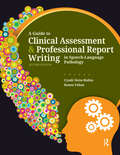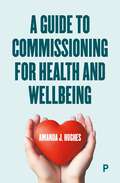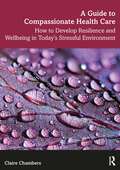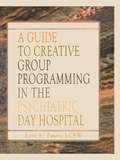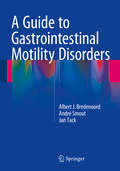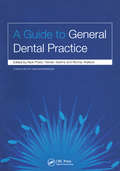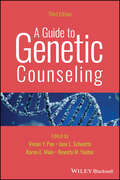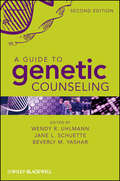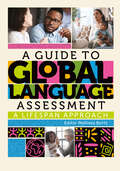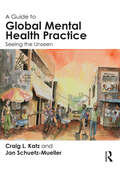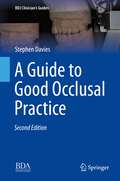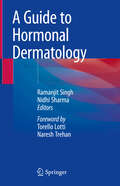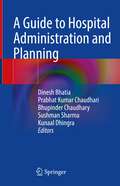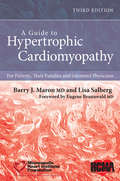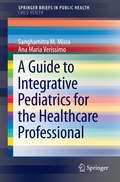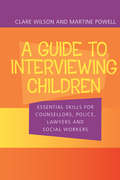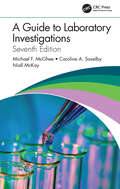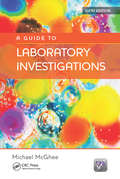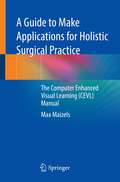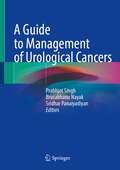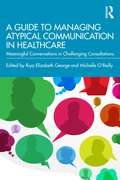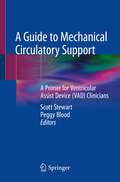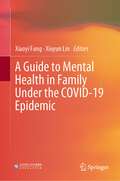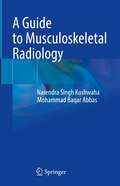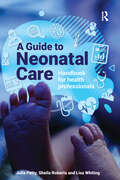- Table View
- List View
A Guide to Clinical Assessment and Professional Report Writing in Speech-Language Pathology
by Renee Fabus Cyndi Stein-RubinLearning to assess speech and language disorders and write diagnostic reports may be an overwhelming experience, especially when most texts don’t cover both topics at once. With that in mind, A Guide to Clinical Assessment and Professional Report Writing in Speech-Language Pathology, Second Edition combines the latest assessment protocols and diagnostic techniques with vital diagnostic report writing tools into a single definitive guide. Cyndi Stein-Rubin, Renee Fabus, and their contributors recognize that clinical assessment is inextricably linked to report writing and have updated this Second Edition to synthesize the two. Following the introductory chapters, which discuss the basics of assessment and report writing, each subsequent chapter focuses on a particular disorder, provides in-depth assessment tools, and presents a corresponding sample report. Key Features: An inventory and explanation of formal and informal assessment measures A glossary of key vocabulary Sample case histories with assessment tools Relevant and useful interview questions Each disorder’s background and characteristics Assessment parameters A differential diagnosis section A model report The accessible format of A Guide to Clinical Assessment and Professional Report Writing in Speech-Language Pathology, Second Edition will help students learn how to assess and document speech and language disorders and will also make for a perfect reference for them as clinicians for years to come.
A Guide to Commissioning Health and Wellbeing Services
by Amanda J. HughesAre you a health and social care commissioner navigating the ever-changing commissioning landscape? With challenges such as limited funding, changing demands and global pandemics, we need to be clear on why, what and how we commission effectively. This book offers you a warm welcome into the often-complex world of healthcare commissioning. Amanda J. Hughes shares personal insights from her commissioning career and practical guidance that will demystify the commissioning cycle and ease the journey as you strive to achieve the best outcomes for the population. This book will help you to ensure valuable resources are directed to those with most need, that care is fair and accessible and that the solutions you put into place are sustainable for the longer term.
A Guide to Compassionate Healthcare: How to Develop Resilience and Wellbeing in Today’s Stressful Environment
by Claire ChambersA Guide to Compassionate Health care looks at how to maintain wellbeing in today’s challenging healthcare environments, enabling practitioners to make a positive difference to the care environment whilst providing compassionate care to patients.
A Guide to Creative Group Programming in the Psychiatric Day Hospital
by Lois E PassiUnlike any other text that discusses day hospital programming, A Guide to Creative Group Programming in the Psychiatric Day Hospital contains protocols for the invention of new groups, saving you the time and effort needed to create one yourself. Intended for social workers, psychologists, and occupational therapists, this book introduces new and unique methods on how to invent or manage groups for a day hospital program, inpatient unit, or intensive outpatient program. The text also includes exercises that address the topics of motivation, self-esteem, shifting cognitive distortions, and risk-taking in relationships. Because the protocols were created with different types of patient groups in mind, this book contains ideas not offered in typical treatment settings. A Guide to Creative Group Programming in the Psychiatric Day Hospital is designed to help clinicians capture the interest of patients and to promote the discourse of important treatment issues by providing: 50 protocols for operating existing day hospital, inpatient or outpatient groups advice, professional opinions, and notes from the author to the clinician on all protocols exercises to help patients strengthen their abilities to handle the activities of daily living and socialization several hypothetical exercises, complete with a list of preparations, a description of the activity, and progress notes from observations with patient assessments numerous examples that use parts of popular movies to create new groups and stimulate discussion comprehensive, easy-to-follow instructions for both clinicians and patients The protocols in A Guide to Creative Group Programming in the Psychiatric Day Hospital contain detailed example activities complete with worksheets, skits, sample discussions, and hypothetical patient reactions to certain topics. Many exercises request that the patient set goals for himself or herself before starting a new topic. In addition, there is suggested homework for the patient to complete after a topic has been discussed, allowing you to monitor what your patients have learned and how they have improved after the exercise. After reading A Guide to Creative Group Programming in the Psychiatric Day Hospital, you&’ll be ready to treat your patients using easy, effective methods that will lead to successful group discussions and lessen the chance of patient relapse.
A Guide to Gastrointestinal Motility Disorders
by Jan Tack André Smout Albert J. BredenoordThis book describes the causes and clinical management of functional gastrointestinal disorders in a readily understandable way, with the aid of many clear illustrations. The concrete and practical advice provided will be most helpful in the clinical practice of both the general practitioner and the medical specialist. Functional disorders of the gastrointestinal tract, such as gastroesophageal reflux disease, functional dyspepsia, and irritable bowel syndrome, are very common and chronic conditions. Despite the recent publication of many scientific papers on their diagnosis and treatment, much remains unclear, and management is still considered challenging. This practice-oriented book will be an ideal source of reliable up-to-date guidance for all who care for these patients.
A Guide to General Dental Practice: v. 1, Relationships and Responses
by Murray Wallace Nick Priest Hardev SeehraThis work includes a foreword By Hew Mathewson, President, General Dental Council. This book is an excellent ready reference for every dental practice to have on hand. Full of practical advice and helpful tips, it offers independent and impartial guidance, especially for new dentists and other staff. It assists competence and provides a thorough understanding of all areas needed for good patient care and professional responsibility. It covers aspects of care including history taking and prescribing, and topics including law, ethics and clinical governance. This completely up to date resource is an essential handbook for all dentistry students and recent vocational training graduates, as well as dental vocational trainers. "Leaving VT to move into practice is an exciting and challenging step and this guide is one of those things you will never know you needed until you cannot find it. It is an incredibly useful collection of information produced by a small group of your colleagues. Until such time as you really need it why not look through it, you will find it helpful and reassuring." - Hew Mathewson, in the Foreword.
A Guide to Genetic Counseling
by Jane L. Schuette Beverly M. Yashar Vivian Y. Pan Karen E. WainA comprehensive 3rd edition of the bestselling, gold-standard textbook in genetic counseling The medical and scientific knowledge, areas of practice, and individuals and families served by genetic counseling have evolved enormously since the advent of this profession. Since 1998, A Guide to Genetic Counseling has served as the field’s seminal text both in the US and internationally, training generations of genetic counselors to serve patients and deliver high-quality guidance and care. Ongoing developments in the practice of genetic counseling and genetic testing play key roles in expanding the ways that genetic based care can support individuals and families as they make difficult and life altering decisions. This updated version reflects these changes and the increasing body of supporting research. It is a must-own for anyone looking to understand the principles and guidelines of this essential component of medicine. Readers of the third edition of A Guide to Genetic Counseling will also find: Every chapter significantly updated to reflect the latest research and practice standardsA text written by genetic counselors for genetic counselors A practice-driven volume that reflects the guidelines from the Accreditation Council of Genetic Counseling and the American Board of Genetic Counseling A Guide to Genetic Counseling is an ideal resource to support the training of the next generation of genetic counselors – including students of both national and international programs, instructors, clinical supervisors, program directors, and practicing genetic counselors.
A Guide to Genetic Counseling
by Jane L. Schuette Beverly Yashar Wendy R. UhlmannThe first book devoted exclusively to the principles and practice of genetic counseling--now in a new editionFirst published in 1998, A Guide to Genetic Counseling quickly became a bestselling and widely recognized text, used nationally and internationally in genetic counseling training programs. Now in its eagerly anticipated Second Edition, it provides a thoroughly revised and comprehensive overview of genetic counseling, focusing on the components, theoretical framework, and unique approach to patient care that are the basis of this profession. The book defines the core competencies and covers the genetic counseling process from case initiation to completion--in addition to addressing global professional issues--with an emphasis on describing fundamental principles and practices.Chapters are written by leaders in the field of genetic counseling and are organized to facilitate academic instruction and skill attainment. They provide the most up-to-date coverage of:The history and practice of genetic counselingFamily historyInterviewingCase preparation and managementPsychosocial counselingPatient educationRisk communication and decision-makingMedical genetics evaluationUnderstanding genetic testingMedical documentationMulticultural counselingEthical and legal issuesStudent supervisionGenetic counseling researchProfessional developmentGenetics education and outreachEvolving roles and expanding opportunitiesCase examplesA Guide to Genetic Counseling, Second Edition belongs on the syllabi of all medical and human genetics and genetic counseling training programs. It is an indispensable reference for both students and healthcare professionals working with patients who have or are at risk for genetic conditions.
A Guide to Global Language Assessment: A Lifespan Approach
by Mellissa BortzFor decades, the speech-language therapy profession has expressed the need for the development of language assessment materials in languages other than English for children and adults. A Guide to Global Language Assessment: A Lifespan Approach aims to meet this need by providing comprehensive information about how to assess the language of bi- and multilingual and culturally diverse clients across the world.Featuring the viewpoints of contributors from around the world, A Guide to Global Language Assessment also boasts a complete database of available global language assessments.What’s included in A Guide to Global Language Assessment: Case studies, assessment frameworks, and resources for conducting global language assessments for culturally and linguistically diverse populations An array of language assessment methods across a continuum such as ethnographic and dynamic assessments, narratives, and standardized language assessment Methods for developing local norms A Guide to Global Language Assessment: A Lifespan Approach is an essential tool for empowering current and future speech-language therapists, professors, and researchers to address global language assessment across the lifespan.
A Guide to Global Mental Health Practice: Seeing the Unseen
by Craig L. Katz Jan Schuetz-MuellerDrawing on the authors’ experience in developing and implementing global mental health programs in crisis and development settings, A Guide to Global Mental Health Practice: Seeing the Unseen is designed for mental health, public health, and primary care professionals new to this emerging area. The guide is organized topically and divided into four sections that move from organizing and delivering global mental health services to clinical practice, and from various settings and populations likely to be encountered to special issues unique to global work. Case studies based around a central scene are threaded throughout the book to convey what global mental health work actually involves. Mental health professionals of all backgrounds, including social workers, nurses, nurse practitioners, psychologists, and psychiatrists, as well as public health professionals and community level medical professionals and mental health advocates will benefit from this engaging primer. It is the book for anyone committed to addressing mental health issues in a low resource or crisis-hit setting, whether international or domestic.
A Guide to Good Occlusal Practice (BDJ Clinician’s Guides)
by Stephen DaviesThis book considers occlusion within the different disciplines of clinical dentistry, taking into account the challenges specific to each, in order to develop guidelines of good occlusal practice (GGOP). The GGOP for each discipline has benefited from an authoritative contribution of a recognised specialist in that field. Readers will find full description of what constitutes good occlusal practice in, for example, simple and advanced restorative dentistry, removable prosthodontics, the restoration of the worn dentition and implantology. It is clearly explained why and how the GGOP differ in the various branches of dentistry, the key point being that it is the support for the occlusal surfaces that determines GGOP. One of the foundations of this work is that an occlusion can only be judged by the tissue reactions to it: there is no such thing as an intrinsically bad occlusion or malocclusion. Today it remains the case that many dentists feel that occlusion represents an important gap in their knowledge; indeed, some qualify with little more than the belief that “occlusion is important”. Their vulnerability in this area of clinical practice is confirmed when early cases fail to go as well as hoped. In providing comprehensive guidance on good occlusal practice in different contexts, this book will be of value for a wide range of dental practitioners.
A Guide to Hormonal Dermatology
by Nidhi Sharma Ramanjit SinghThis book covers all aspects of how various Hormonal diseases affect Skin Health. It covers essential parts of the most common Hormonal disease - Polycystic Ovarian Disease (PCOD), i.e., its Pathogenesis, investigations, and individual clinical features with their Line of management.Chapters also provide information about other common yet less discussed hormonal issues like- Diabetes, Thyroid disease, and obesity affecting the skin and what signs and symptoms should be looked for in such patients for early diagnosis and treatment.Hence, this book assists Dermatologists, Consulting Physicians, Post Graduates, and Interns in a holistic understanding and practical management of standards as well as other miscellaneous issues like Diet and Hormones and Urticaria and Hormones.
A Guide to Hospital Administration and Planning
by Prabhat Kumar Chaudhari Dinesh Bhatia Bhupinder Chaudhary Sushman Sharma Kunaal DhingraThis book is a compilation of work by experts from the different domains of the healthcare industry, ranging from hospital planning to quality management, clinical services to disaster management.Healthcare organizations, being diverse, sensitive, and intricate, warrant thorough and flawless planning. The structure should be not only operationally efficient but also safe for its occupants and visitors. It starts with a brief introduction of the healthcare sector at different levels. It also attempts to justify how the changing healthcare landscape paved the way for establishing a contemporary and ever-evolving specialty of Hospital planning and designing, which is dynamic and frequently requires continuous improvements and updates.Clinical and non-clinical departments have been separately classified in this book, and their respective standards and guidelines have been incorporated while describing the planning concepts. Critical areas of a hospital such as ICU, CCU have been detailed precisely as the operational requirements and level of different sophistication required. A chapter on security aspects and disaster management has also been thoroughly envisioned based on the current scenario at the global level. Issues and management of Hospital Acquired Infection are explained in different chapters based on its relevance and application in that particular area.
A Guide to Hypertrophic Cardiomyopathy
by Barry J. Maron Lisa SalbergWritten by the authority on hypertrophic cardiomyopathy (HCM) and an HCM patient, and fully endorsed by the Hypertrophic Cardiomyopathy Association (HCMA), the leading advocacy and support organization, the 3rd Edition of this best-selling guide offers unparalleled insight into all aspects of living with and treating HCM.Accessible and practical, A Guide to Hypertrophic Cardiomyopathy For Patients, Their Families and Interested Physicians 3rd Edition:Answers the most pressing questions posed by patients, their families, and non-specialistshealth professionals involved in their careCovers everything from what is HCM and initial diagnosis of this increasingly prevalentcondition to the latest treatment optionsReflects the first-ever HCM guidelines published by the American Heart Association in 2011
A Guide to Integrative Pediatrics for the Healthcare Professional (SpringerBriefs in Public Health #0)
by Sanghamitra M. Misra Ana Maria VerissimoIn response to the rise in chronic medical conditions--and the growing use of complementary and alternative therapies--among pediatric and adolescent patients, healthcare practitioners are taking a serious look at pediatric integrative medicine (PIM). Although it dovetails with current concepts of preventive medicine, wellness, and patient control, PIM is still an evolving field with its own particular challenges and opportunities. A Guide to Integrative Pediatrics for the Healthcare Professional explores its subject through the more familiar lens of integrative medicine. This concise comprehensive resource synthesizes the knowledge base on a range of therapies commonly associated with PIM, such as acupuncture, herbal remedies, clinical hypnosis, yoga, homeopathy, and therapeutic massage, with findings on their effective use with children. Case examples illustrate uses of PIM modalities with allopathic medicine to treat young patients at various developmental stages, and the authors pinpoint safety and appropriateness concerns, answer licensing questions, and note clinical areas requiring further study. The wide-ranging information contained here will help support interest in PIM at the research, training, and practice levels. Features of the Guide: An introduction to basic concepts in PIM. Trends in IM/PIM education. A survey of complementary and alternative therapies, including biologically-based, body-based, mind-body, energy-based, and alternative whole systems. Current evidence for IM in treating common pediatric conditions. The future of integrative pediatrics. References and links for further information. Offering a front-row seat to the continued expansion of the field, A Guide to Integrative Pediatrics for the Healthcare Professional is a salient text not only for pediatricians but for all healthcare practitioners tasked with improving children's wellbeing.
A Guide to Interviewing Children: Essential Skills for Counsellors, Police Lawyers and Social Workers
by Claire Wilson Martine PowellChildren may be witnesses to crimes or accidents, or suspected victims of abuse or neglect, or they may be involved in some form of legal action such as custody cases. In these situations, they may need to be interviewed formally, and if this is not done properly, incorrect or inadequate information may be recorded or the child's position may not be correctly represented later in court. In cases of child abuse, the child may not be the only witness, and the quality of their verbal evidence is critical.A Guide to Interviewing Children is a practical guide the evidential interviewing techniques needed by a range of professionals: social workers, forensic psychologists, lawyers, police and teachers. It outlines basic techniques, explains how to deal with children of different ages (from pre-school to fifteen years), how to deal with parents, the particular issues of sexual abuse, handling multiple interviews of one child and so on. It is written for an international readership, and will be more practical and cover a broader range of contexts than the other titles currently available.
A Guide to Laboratory Investigations
by Michael F. McGhee Caroline A. Saxelby Niall McKayThe seventh edition of this concise, highly practical guide to the interpretation of normal and abnormal laboratory results is fully revised and expanded, with updates on established and familiar tests, as well as interpretations on recent developments.With increasing responsibility being placed on primary care, the book includes guidelines on specific clinical conditions such as heart failure, management of female infertility, specific lipid monitoring in diabetes and guidance for monitoring renal failure. It also includes suggestions for appropriate laboratory tests in certain clinical situations, for example: dementia screen, screening tests when a patient presents with a neuropathy, and appropriate tests for patients presenting with hypertension, chronic fatigue syndrome, erectile dysfunction and gynaecomastia. Completely up-to-date, A Guide to Laboratory Investigations, Seventh Edition remains an essential handbook for all primary care professionals professionals and a valuable reference for medical students and hospital physicians in training and in practice.
A Guide to Laboratory Investigations, 6th Edition
by Mike McGheeThis concise, highly practical guide to the interpretation of normal and abnormal laboratory results is now fully revised and expanded, with updates on established and familiar tests, as well as interpretations on recent developments.With increasing responsibility being placed on primary care, this new edition presents guidelines on specific clinical conditions such as heart failure, management of female infertility, specific lipid monitoring in diabetes and guidance for monitoring renal failure. It also includes suggestions for appropriate laboratory tests in certain clinical situations, for example: dementia screen, screening tests when a patient presents with a neuropathy, and appropriate tests for patients presenting with hypertension, chronic fatigue syndrome, erectile dysfunction and gynaecomastia. Completely up-to-date, A Guide to Laboratory Investigations, Sixth Edition remains an essential reference for all healthcare professionals.
A Guide to Make Applications for Holistic Surgical Practice: The Computer Enhanced Visual Learning (CEVL) Manual
by Max MaizelsThis book aims to enable healthcare workers in creating online learning tools for their specific surgical procedures. Providing an e-learning base by which healthcare workers can create customized procedural training materials, this book empowers practitioners to instruct their staff both within and across specific institutions or surgical areas. Supplying surgical leads with the tools required to inform their team members of what they need to know, what they will be expected to do, and when they will be expected to do it, the methods put forth in this book assist healthcare teams in working more closely and efficiently. Using the techniques this text describes, staff surgeons will be able to streamline their surgeries and support each of their staff members to perform their best. Focused on pediatric urological healthcare workers, each chapter demonstrates real-world applications for the development of codified training procedures. Supplemented with downloadable files for customization, the principles presented in this book apply to diverse specialties including but not limited to urology, orthopedics, obstetrics, and ophthalmology. A Guide to Make Applications for Holistic Surgical Practice: The Computer Enhanced Visual Learning (CEVL) Manual emphasizes practical approaches to the development of training methods for the codification of procedure performance within or across specific institutions or surgical leads.
A Guide to Management of Urological Cancers
by Prabhjot Singh Brusabhanu Nayak Sridhar PanaiyadiyanThe book provides comprehensive review of common uro-oncology cases mainly focusing on its management aspect. It includes diagnosis and clinical staging, surgical management, pathological staging, adjuvant treatment and follow up. It provides current evidence-based approaches for the management of common urological malignancies. All the chapters are written uniformly in a simple yet informative manner by experts in their respective fields. It contains well-prepared illustrations, relevant clinical images and flowcharts. The book is helpful for practicing urologists, uro-oncologists, oncologists as well as urology trainees, uro-oncology fellows in providing a holistic approach to cancer patients. It helps them to develop critical thinking and encourage discussion toward improving the overall care of the patients.
A Guide to Managing Atypical Communication in Healthcare: Meaningful Conversations in Challenging Consultations
by Michelle O’Reilly Riya Elizabeth GeorgeThis book presents a supportive and practical guide for healthcare professionals and trainees in a way that considers a wide spectrum of atypical communication conditions, their impact on everyday healthcare interactions, and the social and cultural contexts in which interactions with atypical communicators take place. A growing number of patients have been reporting atypical capacity for communication, creating unique challenges for healthcare professionals and patients in forming meaningful clinical interactions. In this book, leading international scholars from a range of healthcare professions provide insight into optimal management for those with atypical communication conditions. This includes speech, language, and hearing impairments. Chapters provide optimal management strategies, case examples, clinical recommendations, and recommended resources relevant for a range of healthcare professionals. The first collection of its kind, this book supports inter-professional practices and serves as a useful guide for those with an interest in clinical communication, and communication and diversity. This book will be a valuable resource for health and mental healthcare professionals as well as undergraduate and postgraduate students in healthcare and allied healthcare courses. It can be included as recommended reading material in clinical communication curricula.
A Guide to Mechanical Circulatory Support: A Primer for Ventricular Assist Device (VAD) Clinicians
by Scott Stewart Peggy BloodThis unique book details a multidisciplinary approach for providers caring for the Mechanical Circulatory Support (MCS) patient. Authors discuss the history of MCS, patient selection, surgical and post-operative care, mobility and nutritional issues for this subgroup of patients, along with outpatient management. They are expert clinicians in the field of MCS and Extracorporeal Membrane Oxygenation (ECMO), who provide direct patient care, conduct research, publish and maintain current leadership positions within the International Society of Heart and Lung Transplant and International Consortium of Circulatory Assist Clinicians.Non-clinical issues including Regulatory, Reimbursement, Administration, Program Development and links to Professional Organizations supporting MCS Clinicians are presented in the book that will be of great value to Nurses first, but also to Advanced Practice Providers (NP/PA), Dieticians, Physical Therapists and Administrators.
A Guide to Mental Health in Family Under the COVID-19 Epidemic
by Xiaoyi Fang Xiuyun LinThis book tells us from a professional perspective how to deal with stress response in the family, effectively address family problems in the epidemic, and handle the infectious emotions. This book is a profound explanation of the new stress, conflicts, and problems arising at home amid the epidemic. It provides people with a psychological self-help scale to effectively distinguish the normal and abnormal states of psychological response. Besides, it also provides professional psychological assistance and suggestions for special groups, including children, the elderly, the quarantined, and the bereaved, in order to help all families actively respond to the epidemic with the power of psychology.
A Guide to Musculoskeletal Radiology
by Narendra Singh Kushwaha Mohammad Baqar AbbasThis book covers all the aspects of orthopedic skeletal radiographic imaging or musculoskeletal radiology. It fills the gap and simply presents essential concepts. It emphasizes radiology principles as well as important surgical aspects. It assists readers in understanding the fundamentals of a radiograph and its interpretation. It includes a description of radiographs helpful for students and surgeons. The book is suitable for practicing orthopedic surgeons, radiologists and postgraduate students of orthopedic surgery, FNB students during their specialization fellowship.
A Guide to Neonatal Care: Handbook For Health Professionals
by Julia Petty Lisa Whiting Sheila RobertsA key text for all those involved in the care of neonates, including nurses, midwives and nursing students, providing a single source of valuable, accessible and fully up-to-date information about neonatal care. This book will better equip those working in the neonatal field with the knowledge and skills they need to care for neonates in their first year of life. Integrated learning tools, including algorithms, flow charts, summary tables, bulleted checklists and reflective questions, encourage critical thinking and aid understanding. These are accompanied by clear supporting text in line with relevant and recent evidence and research. Other helpful features include Stop and Think boxes and alerts for Standard Precautions and Local Variations Neonatal care is a speciality that often requires health professionals new to the field to acquire a discipline-specific set of skills. Care practices covered include working out drug dosages, fluid rates and calculations, looking up normal blood ranges and understanding the mode of ventilation a neonate is receiving, to name just a few. Overall, this book will empower neonatal carers as they improve their skills and achieve the best results for those in their care.
